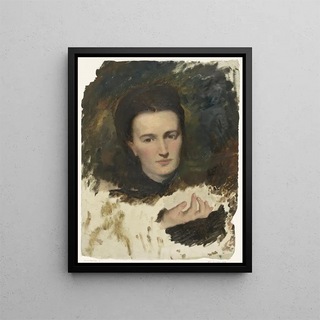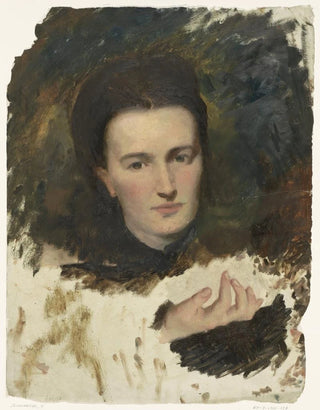Art print | Portrait of a woman - Thérèse Schwartze Source: Reproduction | Portrait d'une femme - Thérèse Schwartze


View from behind

Frame (optional)
Portrait of a Woman - Thérèse Schwartze – Captivating Introduction
The "Portrait of a Woman" by Thérèse Schwartze is a work that transcends the simple frame of a portrait to capture the very essence of femininity at the end of the 19th century. This painting, imbued with delicacy and depth, invites the viewer to delve into the intimacy of its subject. Through a subtle play of light and shadow, Schwartze succeeds in bringing her model to life, offering a window into a world where elegance and grace are omnipresent. This portrait is not merely a representation but a true visual narration that evokes emotions and reflections.
Style and uniqueness of the work
Thérèse Schwartze's style is distinguished by its realistic approach, combined with an impressionist sensitivity. In "Portrait of a Woman," every detail is carefully crafted, from facial features to the textures of clothing. The color palette, soft and nuanced, creates an atmosphere that is both serene and captivating. The artist manages to establish a dialogue between the subject and the viewer, making the work almost alive. The model's eyes, filled with gentle melancholy, seem to tell a personal story, while the blurred background emphasizes the presence of the central figure. This stylistic choice highlights the individuality of the depicted woman, while also demonstrating Schwartze's technical skill.
The artist and her influence
Thérèse Schwartze, an emblematic figure of Dutch painting, managed to establish herself in an art world dominated by men. Born in 1851, she developed a unique style that combines tradition and modernity. Her training with renowned masters shaped her keen sense of observation and representation. Schwartze not only painted portraits of women but also contributed to redefining the role of women in art. Her influence extends beyond her era, inspiring many contemporary artists to explore the complexity of feminine identity. Through her works, she paved the way for a new understanding of women, both as subjects of art and as artists in their own right.
A wall decoration of

Matte finish

View from behind

Frame (optional)
Portrait of a Woman - Thérèse Schwartze – Captivating Introduction
The "Portrait of a Woman" by Thérèse Schwartze is a work that transcends the simple frame of a portrait to capture the very essence of femininity at the end of the 19th century. This painting, imbued with delicacy and depth, invites the viewer to delve into the intimacy of its subject. Through a subtle play of light and shadow, Schwartze succeeds in bringing her model to life, offering a window into a world where elegance and grace are omnipresent. This portrait is not merely a representation but a true visual narration that evokes emotions and reflections.
Style and uniqueness of the work
Thérèse Schwartze's style is distinguished by its realistic approach, combined with an impressionist sensitivity. In "Portrait of a Woman," every detail is carefully crafted, from facial features to the textures of clothing. The color palette, soft and nuanced, creates an atmosphere that is both serene and captivating. The artist manages to establish a dialogue between the subject and the viewer, making the work almost alive. The model's eyes, filled with gentle melancholy, seem to tell a personal story, while the blurred background emphasizes the presence of the central figure. This stylistic choice highlights the individuality of the depicted woman, while also demonstrating Schwartze's technical skill.
The artist and her influence
Thérèse Schwartze, an emblematic figure of Dutch painting, managed to establish herself in an art world dominated by men. Born in 1851, she developed a unique style that combines tradition and modernity. Her training with renowned masters shaped her keen sense of observation and representation. Schwartze not only painted portraits of women but also contributed to redefining the role of women in art. Her influence extends beyond her era, inspiring many contemporary artists to explore the complexity of feminine identity. Through her works, she paved the way for a new understanding of women, both as subjects of art and as artists in their own right.
A wall decoration of






